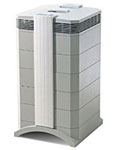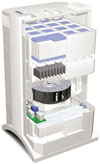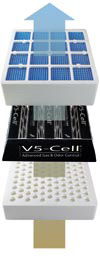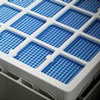AMAZON multi-meters discounts AMAZON oscilloscope discounts
Fact: We spend 90% of our existence indoors.
Think about it: whether we're at work, at school, in the grocery store, in hospitals, gyms, airplanes, in our cars and most importantly, of course, at home, we're almost always inside. In many ways, the quality of the indoor air we and our families breathe is more important to our health than the air we breathe outdoors. This fact was effectively investigated and established by the Harvard Center for Risk Analysis (HCRA). On this site, HCRA openly asks visitors "What's the Least Regulated form of Air Pollution?" It's indoor air. And while OSHA (U.S. Occupational Safety and Health Administration) can regulate -- to some extent -- the quality of air you breathe at work, you're pretty much on your own out of the work place.
At dust-control.us, we have researched many different types of air purifiers, air "cleaners" and air-filtration systems. When someone asked us to come up with a "best of" list, we had to think carefully because different people have different requirements. For example, some people have pets, some are smokers, some have allergies, some live in an area where there is air pollution from traffic and factories (these things do make it inside the house) and, of course, many have combinations of these and other filtration-requiring conditions.
Our top picks for indoor-air purification:
IQAir HealthPro HEPA Air Purifier This is the best-rated air purifier based on our extensive research. When our vendor-partner tested this air purifier, virtually nothing escaped its Hyper-HEPA filter. Equipped with superior technological features such as a large-capacity pre-filter, filter change indicator lights, a HEPA filter efficiency rating second to none our vendor-partner has tested, and six fan-speed settings, the IQAir is pretty much as good as it gets. The Hyper-HEPA filters out smaller particulates than other filters, and these tiny particles are the ones which are actually harmful to your health. We are particularly impressed with its robust pre-filter which screens out 90% of all larger allergens. We can find no equal in any other purifier. The quality of its carbon fill is the best you can find, so simply put, it does a better job. Warning lights tell you when to change any of the filters. No expense has been spared in the manufacturing of this machine. The IQAir air purifiers series filters out pet dander, viruses, pollen, dust mites, mold spores, odors, and bacteria. This air purifier is for those who know their health deserves only the very best and who want to ensure clean air in their homes. IQAir HealthPro Series Air Purifiers are ideal for people who:
Click here IQAir HealthPro Series Air Purifiers: Which IQAir purifier is right for you...
Special Features of IQAir HealthPro Series Air Purifiers HEPA Filtration, and then some: 1. Exceeds HEPA standard: IQAir HealthPro is the
world’s first air cleaner to pass the world’s most stringent HEPA
filter test: EN 1822. Longer Air Filter Life: 1. High-efficiency pre-filtration: While most air
purifiers use pre-filters with particle efficiencies well below 20%,
IQAir systems typically retain over 90% of particle mass in the pre-filter
so the HEPA and gas phase filter are better protected for a longer
life.
How IQAir HealthPro Series Air Purifiers Work The Air Flow of the Healthpro air purifier: The IQAir HealthPro air purifiers take in air from the bottom of the unit, the air is passed through pre-filter then through the fan, then the gas media, then through the HEPA filter, and then the air is vented out of the sides just below the top of the unit from a 320 degree, 77 square inch opening. Air intake:
Pre-filter element: fine dust filtration with 55% efficient media at 0.3 microns (ASHRAE 90-95%, class F8) HEPA filter element: filtration efficiency of 99.97% at 0.3 microns Fan:
Air outlet diffuser: returns clean, low turbulence, low velocity air
Click here for more technical information on our IQAir Products See this chart for a comparison of filtration rages between the IQAir models above. |
If you can't shell out the big bucks for an IQAir, you may be very happy with the Alen 350 -- a best buy.
If you're bothered by air-cleaner noise, we suggest you take a look at this model.
There are more recommendations on Page 2 of this article. Also browse our entire catalog of air-filtration and allergy-controlling solutions.
How we research and evaluate air cleaners and air-purification systems:
We're in the dust control business -- so we could try to convince you by saying "... in our own experience as 'experts' and -- through long-term ownership and use we recommend such and such an air cleaner...". But, statistically speaking, that in and of itself, is not worth a hill of beans -- even if we owned or used a hundred separate products.
Internet-based research -- our most-widely-used and most-effective research tool becauses it allows us to gather statistically significant amounts of information (data samples).
Here's where we looked for data:
- Personal reviews left by product buyers/users at Amazon.com
and other, similar e-commerce sites. We went though a lot of data here
and really examined each comment
carefully -- personal opinion can only go so far. That said, a broad
consensus on a particular brand or model do indicate trends for better products. By this
we mean that if a lot of people at Amazon.com
or other sites left consistently favorable reviews about a particular
brand or model, then that says something.
- Internet forums and bulletin boards where people talk
about their experience with various home appliances. Example: Epinions.com.
- "Professional" reviews from so-called "experts". A lot of
these are biased because of "pay offs" from the product manufacturer.
But, again, we looked for consensus amongst lots of different reviewers and review web sites and set our bogus-detection
meter on high.
- Opinions from respectable journals and periodicals,
such as Consumer Reports and Consumer Guide.
- Non-commercial, non-profit resources (see References and Resources below). This allows us to take a hard look at the facts about indoor air pollution -- how it is created and how it is controlled. Companies selling indoor-air products don't qualify!
Resources and Further Reading:
(1) U.S. EPA on Indoor Air Quality (IAQ) — Topically exhaustive information on this subject. No commercial bias!
(2) MedlinePlus -- Indoor Air — Another high-quality resource from the U.S. Government. No commercial bias!
(3) Indoor Air Pollution — Thorough, well-written information on Indoor Air Pollution form Lawrence Berkeley National Labs -- University of California for the U.S. Department of Energy. No commercial bias!
(4) California Indoor Air Quality (IAQ) Program — it's mission is to "conduct and promote the coordination of research, investigations, experiments, demonstrations, surveys, and studies relating to the causes, effects, extent, prevention, and control of indoor pollution in California". Excellent Indoor Air Quality Information on this site. No commercial bias!
(5) World Health Organization (WHO) on Indoor air pollution — "Cooking and heating with solid fuels on open fires or traditional stoves results in high levels of indoor air pollution. Indoor smoke contains a range of health-damaging pollutants, such as small particles and carbon monoxide, and particulate pollution levels may be 20 times higher than accepted guideline values." (No commercial bias!) Read more...
(6) U.S. Department of Labor -- Occupational Safety and Health Administration: Indoor Air Quality: Hazard Recognition. "Indoor air quality (IAQ) problems can be caused by ventilation system deficiencies, overcrowding, tobacco smoke, microbiological contamination, outside air pollutants, and off gassing from materials in the office and mechanical equipment. Related problems also may include comfort problems due to improper temperature and relative humidity conditions, poor lighting, and unacceptable noise levels, as well as adverse ergonomic conditions and job-related psycho-social stressors." Read more here...
(7) U.S. Department of Labor -- Occupational Safety and Health Administration: Request for Information on Occupational Exposure to Indoor Air Pollutants. "This notice raises major issues which the Agency needs to consider in determining whether regulatory action is appropriate and feasible to control health problems related to poor indoor air quality. The issues on which comment is requested are organized into five broad categories: (1) Definition of and Health Effects Pertaining to Indoor Air Quality; (2) Monitoring and Exposure Assessment; (3) Controls; (4) Local Policies and Practices; and (5) Potential Content of Regulation." Read more here....
(8) U.S. Department of Labor -- Occupational Safety and Health Administration: Indoor Air Quality -- "...(OSHA) proposes to adopt standards addressing indoor air quality in indoor work environments. The basis for this proposed action is a preliminary determination that employees working in indoor work environments face a significant risk of material impairment to their health due to poor indoor air quality, and that compliance with the provisions proposed in this notice will substantially reduce that risk." Read more here...
OSHA flaws — While the levels of indoor industrial air pollution are regulated by OSHA (Occupational Safety and Health Admin.) don't implicitly count on OSHA "standards" to protect you. OSHA "standards" are often more permissive than those of agencies that monitor other environments, because the most vulnerable populations to air pollution -- younger kids, the elderly, or those with compromised immune systems -- are usually not the types of people who spend a great deal of tine in workplace environments.




